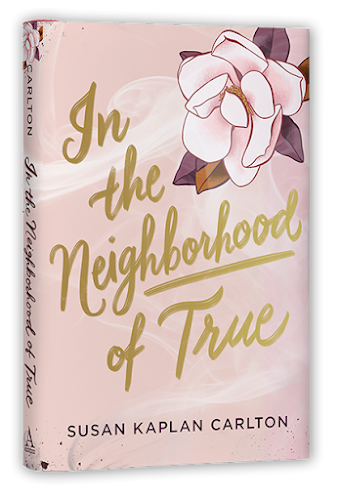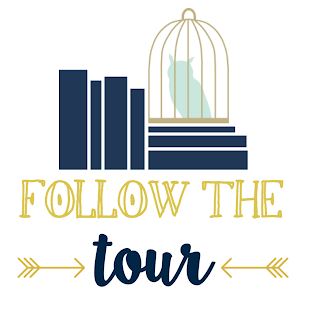Check out a fun guest post from the author and the tour giveaway below...

In the Neighborhood of True
By Susan Kaplan CarltonYA Historical
Hardcover, Audiobook & ebook, 320 Pages
April 9th 2019 by Algonquin Young Readers
Summary
A powerful story of love, identity, and the price of fitting in or speaking out.
After her father’s death, Ruth Robb and her family transplant themselves in the summer of 1958 from New York City to Atlanta—the land of debutantes, sweet tea, and the Ku Klux Klan. In her new hometown, Ruth quickly figures out she can be Jewish or she can be popular, but she can’t be both. Eager to fit in with the blond girls in the “pastel posse,” Ruth decides to hide her religion. Before she knows it, she is falling for the handsome and charming Davis and sipping Cokes with him and his friends at the all-white, all-Christian Club.
Does it matter that Ruth’s mother makes her attend services at the local synagogue every week? Not as long as nobody outside her family knows the truth. At temple Ruth meets Max, who is serious and intense about the fight for social justice, and now she is caught between two worlds, two religions, and two boys. But when a violent hate crime brings the different parts of Ruth’s life into sharp conflict, she will have to choose between all she’s come to love about her new life and standing up for what she believes.
Guest Post:
Nine Things Ruth Learns About Atlanta, Circa 1958
- The pink book: The rules of etiquette were all recorded in a little pink booklet called Belles of the Ball: A Pre-Debutante Guide. Among the gems Ruth finds inside: “Never show one’s bosom before evening.” And: “A lady never walks while holding a cigarette. Indeed, a lady should avoid smoking in public, as the habit borders on the unattractive.”
- Capital-C country clubs: Ruth spends much of the book wanting to attend various dances, including the Magnolia Ball, the social event of the season. Once there, in what her grandmother calls the Capital-C Club, it occurs to Ruth that she was in a club that wouldn’t allow Jews to join. “A part of me was oddly proud—defiantly proud—to be in a club that wouldn’t allow me to join. Here I was standing amid the loveliness. My feet on the marble, my lips on the glasses. They didn’t want me, yet I was here. But the other half—the getting-louder-in-my-chest half—called bunk. If no one knew who I was, if no one knew I wasn’t welcome, then I wasn’t standing up for a single thing. I was back to being invisible, and what good came from that?”
- Shalom y’all: The temple at the heart of the book is fictional. But the seed of the story is inspired by a real-life event—the bombing of Atlanta’s oldest synagogue, the Hebrew Benevolent Congregation, better known simply as “the Temple.” In the 1950s and ’60s, the Temple was a center for early civil-rights advocacy, led by the outspoken and charismatic Rabbi Jacob Rothschild, who urged his (sometimes reluctant) congregants to join the fight for racial justice.
- The Fabulous Fox: The Fox theatre in midtown Atlanta—where Ruth and Davis have their official first date—is called the Fabulous Fox for a reason. But as gorgeous as the place is, Ruth is struck by a zigzag line of Negro men and women, boys and girls, queued up outside the building. Davis tells her that’s the colored-only ticket line and it leads to the Crow’s Nest. When I was researching the book, trying to find the details of the Jim Crow balcony and coming up empty, I talked to a docent at the Center for Civil and Human Rights museum in Atlanta who remembered—exactly—what it was like to sit in the segregated Fox.
- The art of sitting properly: At a tea-and-etiquette event, when Ruth has imbibed a smidge too much Southern Comfort, she learns a lady’s leg should be shaped into the letter S—as in ‘secretary.’ The rule is thus:“If a young lady curves her legs into an elegant S shape, a young gentleman will see the length of her limbs, but nothing he has no earthly right to see.”
- The perfect red lipstick: Ruth is a fan of a pinky-red called Cherries in the Snow (which, by the by, is still being made by Revlon). Ruth read in Mademoiselle magazine that red lipstick has power—it draws attention to both your mouth and your words.
- Making news: Ruth’s family is in the news business. Her grandfather, Mr. Hank, is an editor of the paper, and her mother, Alice, is a reporter. In the novel, Mr. Hank had “the boys from the paper” install a Teletype machine, big as a radiator, in his office. It clangs like mad every time a story comes across. As Mr. Hank tells Ruth: “Three dings meant an advisory (something newsy was coming); five dings meant a bulletin (news was happening); ten dings meant a real news flash (a humdinger, in his words).” Only once in the book does the machine ring/ding ten bells.
- Pernicious private schools: At one point, Ruth and her grandfather, Mr. Hank, have a talk about how the neighbourhood reacted after the Supreme Court’s Brown v. Board of Ed decision desegregating schools. Mr. Hank says, “’You know how our neighbors here responded? Our neighbors who favor gradualism—gradually bringing the races together over God knows how many years? Our neighbors...’ He brandished his cigar in the direction of the magnolias. I followed the lit end and saw nothing but loveliness—the flowers, the pool, the sky. ‘They built a pernicious academy—a private academy—that didn’t have to follow the federal law.’” Ruth and sister attend just such an academy.
- Girding
yourself for change in a southern climate: On a very hot day, Ruth steps
into a girdle and tries to wriggle it over her hipbone. But the day’s just
too steamy and so—pink booklet be damned—she peels the thing off. Later,
she’s told the secret by a new friend: put the girdle in the freezer.
About the Author
Susan Kaplan Carlton, a longtime magazine writer, currently teaches writing at Boston University. She lived for a time with her family in Atlanta, where her daughters learned the fine points of etiquette from a little pink book and learned the power of social justice from their synagogue. Carlton’s writing has appeared in Self, Elle, Mademoiselle, Seventeen, Parents, and elsewhere. She is the author of the young adult novels Love & Haight, which was named a Best Book for Young Adults by YALSA and a Best Book by the Children’s Book Committee at Bank Street Books, and Lobsterland.
Tour Schedule
Tour-Wide Giveaway
Win (1) of (2) copies of IN THE NEIGHBORHOOD OF TRUE by Susan Kaplan Carlton (US Only)
Ends April 16, 2019
a Rafflecopter giveaway
Have you read this? Will you be? What do you think of the author's guest post and Atlanta in 1958?




No comments
Post a Comment
I love comments! I try to read and reply to them all. Feel free to agree or disagree and generally share your thoughts with me.